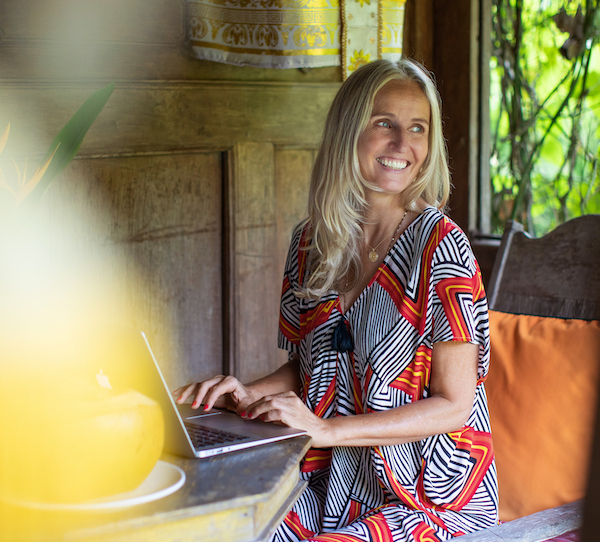The arrival of a new year is always a time of reflection – looking back at the previous year to ponder what went well and what didn’t; at the same time we look ahead at the year to come and wonder? We ponder and wonder. To give that wondering more direction, we tend to create New Year’s resolutions. The yogic answer to a New Year’s resolution is Sankalpa. It is a Sanskrit word and means “will, purpose or determination.” To make a sankalpa is best translated for us today as „to set an intention“.
Why set intentions?
Setting intentions directs the mind and gives us purpose. When we lose track of our purpose, a void is created and we can easily stray off our path. Focusing on what’s important to you creates clarity and self-study (svadhyaya) inspiring you to find your dharma (dharma explained below).
Now what is the difference really between a sankalpa, setting an intention, and a New Year’s resolution?
Resolutions have a tendency to focus on our flaws and mentally perceived negative aspects of ourselves. Let’s take a very simple example: “I want to lose weight, so no more sweets”. Here I’m focusing on what I don‘t want at the same time depriving myself of something I love. Sweets in some instances can even be good for me, if they give me comfort when I’m sad or accompany a chat with a good friend. There is nothing inherently bad, only what we think about it. Then, when we do reach for that ice cream, we feel guilty and beat ourselves up and concentrate on: this will make me gain weight. Resolutions in such form work in the long run like a fad diet with limited chances of success nor creating long-term positive change.
I feel this is why New Year’s resolutions are out of trend and avoided these days instead of something to be inspired by and excited about to ponder & wonder and to give your path a well needed direction.
Sankalpas, however, are quite different to setting New Year’s goals. Sankalpas align with our highest truths. It is the path to dharma, a yogic concept of our life’s purpose, ultimately the answer & reason why we are here. Dharma explains that every human has unique gifts and responsibilities to be shared and enjoyed through this earthly experience. (please read the Bhagavad Gita for more on dharma). It is exactly what feels good to us, what makes us happy, what we are good at and what feels important and meaningful in our lives. When we form a sankalpa, we come from a place of wholeness. The yogic path explains that in our pure essence (atman) we are already perfect as we are – we are always abundant, eternal and whole; there is nothing missing. When we are born we only forget where we come from (this illusion is called Maya in Hindu philosophy and avidya in Yoga) and only „monkey-games“ of the mind lead us astray, beat us up and tell us otherwise. We become therefore vulnerable to match outside conditions, expectations and demands. So – coming from abundance instead of lack we will attract even more of it (Law of Attraction). This way we set the stage for change and success. When I form a sankalpa, rather than focusing on the flaw –
“I need to loose weight”
I frame it in a positive way:
„I am going to eat nutritious food and exercise more because
I want to be healthy, feel good and have more energy.“
Sankalpas then require will, action, self- study and wisdom to make them reality. Since we are aligning with our deepest truth and not just fixing ourselves, we tend to have greater readiness to change.
Sankalpas are connected to the emotions on how something feels, rather than what we think we should do or is good for us or what someone else tells us to do. I ask myself: Does it make me happy? Does it make me feel good?
Instead of following a trend to be as skinny as the models in a magazine, I ask myself: when does my body feel good and when not? Or what job makes me happy? What am I passionate about? Even if I earn less money in the beginning. How do you want to feel in the New Year? Visualize it, feel it.
Then I get asked many times: well then how do I now practically set my intentions?
(the New Year is just a current example; you may set your intentions of course any time, another good time is around the New Moon or whenever your time is right; as you will see below you will read and revise them daily)
So I put together these 8 steps for setting my intentions. Please take pen and paper, ask yourself and write down:
1. What am I passionate about? What do I want to cultivate more in my life? What brings me joy? What makes me feel good?
2. Reflect on your last year – what went well? What is going right in your life? What seems to be working well?
3. What didn’t go so well?What is not going right and where can you make some positive changes?
4. Create a list of intentions Now write down a list to help you create these changes that will lead you to greater fulfillment.
5. Create your personal mantra
Once you read through this list, you will see there is a common underlying pattern. It might be that you lack confidence in several areas or the same basic fear arises. You may not be able to say „No“ and are a „people pleaser“. You may be afraid to be alone or overly attached to someone or something. Whatever your common theme is, with ease it will lead you to your personal mantra. Here are a few examples:
May I be healthy
May I be confident
May I speak my inner truth
May I express my heart’s desire
May I take my time and be patient
May I practice presence
May I be free
Or more specific:
May I follow my passion of singing
May I do my daily yoga practice and meditate
Or in Sanskrit if you were given a personal mantra and feels relevant just now or you feel drawn to a particular one fitting your intentions:
So Ham
Om Namah Shivaya
Please state your mantra focusing on what you want and bring it in the now as if it is happening right now already instead of saying I will, which lies in the future. If you need to, you may of course have more than one mantra or string them together; however, the shorter and more compact the easier to use with your mala and meditation or through your sun salutations and asana practice. Mantras can easily come with visualizations. Using the mantra “May I be healthy” – you see yourself beaming of health and most importantly you feel how it is to be radiant. Your feel bursting with energy. Feeling it is a big part of intention setting and mantras as that supports creating the vibration which is the underlying energy of manifestation.
6. Prayer
Prayers do not have to be religious. For some they come easy and are already daily practice and for others believing into something or anything connected with the words “faith”, “God” or religion” makes the hair stand up on their backs. Yogic prayer is not at all about that. Prayers are part of a personal practice. They may be a form of showing your gratitude, sending off your mantra and releasing the ego within the divinity of nature. Prayers only work if they come from a place of deep humility, so instead of „asking favors“ or handing over the list of wants we may say: „Please show me your will for me and give me the power to carry that out.” This way we connect with your universal purpose that is often still clouded for us, cannot be seen through the eyes of our ego and shifts us naturally into the flow. This way we open the door to live our dharma.
7. Meditate
After having read out your intentions and prayed, I suggest to meditate with your mantra. You may just repeat your mantra in your head during exhale or if it is longer throughout one breath. Me personally, I love the mala (string bead) mediation, with a traditional rudraksha mala (photo above). I like to repeat my personal mantra daily during morning sadhana(practice).
8. Repeat – Sadhana
„Repetition makes the magic rise“
My biggest suggestion of all 8 intention setting points is my recommendation of a daily sadhana – daily practice. Create an altar at home (again, an altar does not need to be religious with sacred statues). It is a place that you return to every day, that carries your energy; a small table with fresh flowers and the photo of your child, your dog or your favorite mountain. It may be decorated with a stone you found in a river or a present from your favorite friend – whatever makes you happy. It is important you create a space for yourself in your home where you can return to daily and that carries your energy. Ideally you mediate here every day, at the same time looking north or north-east (magnetic field). For example, every morning after you wake up and before you are off to work. Light a candle or an incense or both (if you like) and become still and regulate your breath. Then read your list of intentions, say your prayers and finally meditate with your mantra. If you have time for an asana yoga practice after, ah what an ideal start of the day and what an ideal start to another year!
They say it takes 21 days for a habit to form and at times for an intention to manifest; however, these are just numbers. Several channelers said they broke through interestingly enough after 9 months of daily meditation. I suggest to stick with your daily practice like brushing your teeth – as B.K.S Iyengar says:
„Your body is your temple. Keep it clean for you soul to reside in.”
Enjoy!
written by Beate McLatchie

